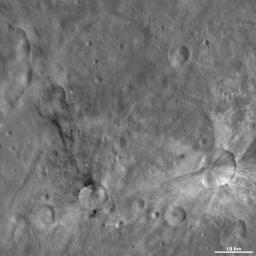This Dawn Framing Camera (FC) image of Vesta shows Sossia and Canuleia craters. Sossia is the crater surrounded by dark material in the bottom left of the image and Canuleia is the larger crater surrounded by bright material in the bottom right of the image. The bright material around Canuleia crater is collected together into broad rays that extend for up to 10 kilometers (6 miles). There are also narrower bands of bright material that originate from just underneath Canuleia's rim and slump towards its center. A roughly 12 kilometer (7.5 mile) long band of darker material ranges from the wall of Canuleia crater to the area surrounding the crater. This band of darker material appears to be overlying the bright material, so it is likely that it is younger than the bright material.
This image is located in Vesta's Urbinia quadrangle, in Vesta's southern hemisphere. NASA's Dawn spacecraft obtained this image with its framing camera on Oct. 25, 2011. This image was taken through the camera's clear filter. The distance to the surface of Vesta is 700 kilometers (435 miles) and the image has a resolution of about 64 meters (210 feet) per pixel. This image was acquired during the HAMO (high-altitude mapping orbit) phase of the mission.
The Dawn mission to Vesta and Ceres is managed by NASA's Jet Propulsion Laboratory, a division of the California Institute of Technology in Pasadena, for NASA's Science Mission Directorate, Washington D.C. UCLA is responsible for overall Dawn mission science. The Dawn framing cameras have been developed and built under the leadership of the Max Planck Institute for Solar System Research, Katlenburg-Lindau, Germany, with significant contributions by DLR German Aerospace Center, Institute of Planetary Research, Berlin, and in coordination with the Institute of Computer and Communication Network Engineering, Braunschweig. The Framing Camera project is funded by the Max Planck Society, DLR, and NASA/JPL.
More information about Dawn is online at http://www.nasa.gov/dawn and http://dawn.jpl.nasa.gov.

 Planetary Data System
Planetary Data System












